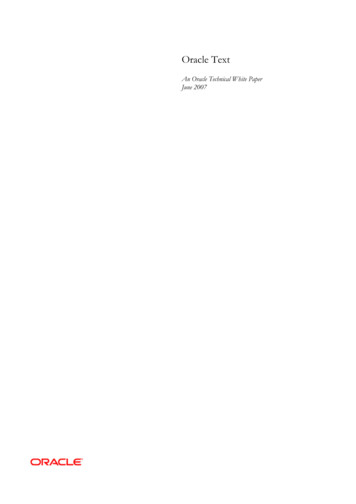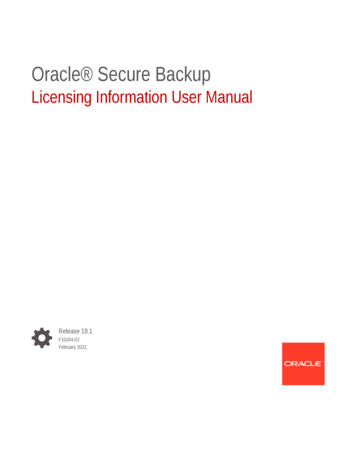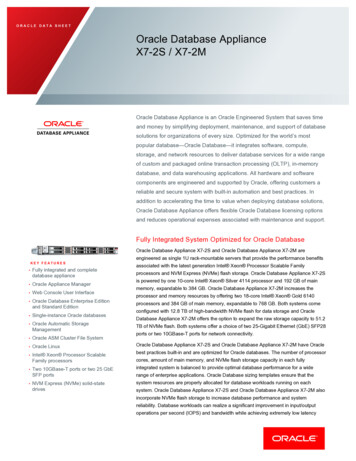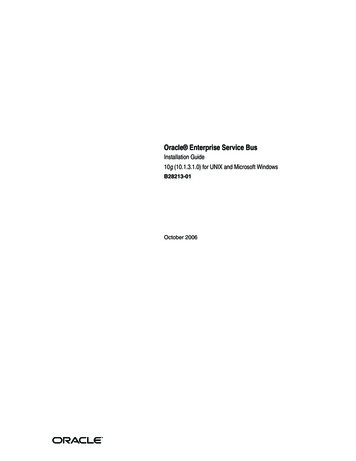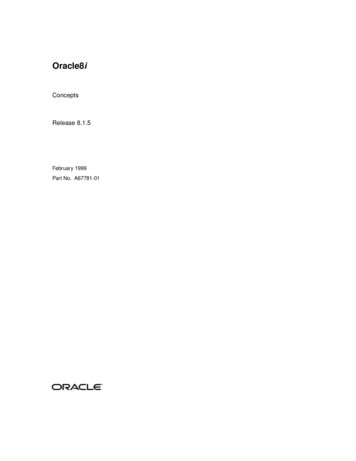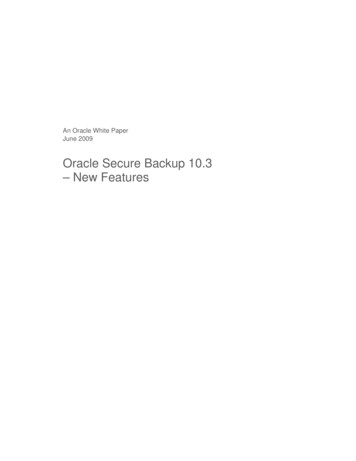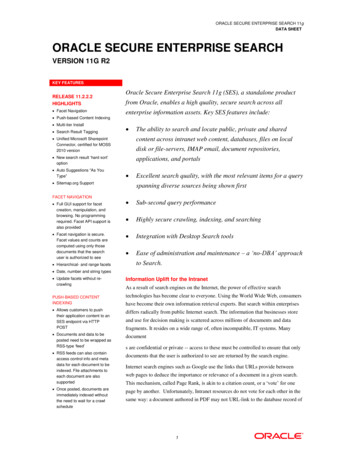
Transcription
ORACLE SECURE ENTERPRISE SEARCH 11gDATA SHEETORACLE SECURE ENTERPRISE SEARCHVERSION 11G R2KEY FEATURESRELEASE 11.2.2.2HIGHLIGHTS Facet Navigation Push-based Content Indexing Multi-tier Install Search Result TaggingOracle Secure Enterprise Search 11g (SES), a standalone productfrom Oracle, enables a high quality, secure search across allenterprise information assets. Key SES features include: The ability to search and locate public, private and shared Unified Microsoft SharepointConnector, certified for MOSS2010 versioncontent across intranet web content, databases, files on local New search result „hard sort‟optionapplications, and portals Auto Suggestions “As YouType”disk or file-servers, IMAP email, document repositories, Sitemap.org SupportFACET NAVIGATION Full GUI support for facetcreation, manipulation, andbrowsing. No programmingrequired. Facet API support isalso provided Facet navigation is secure.Facet values and counts arecomputed using only thosedocuments that the searchuser is authorized to see Hierarchical- and range facetsExcellent search quality, with the most relevant items for a queryspanning diverse sources being shown first Sub-second query performance Highly secure crawling, indexing, and searching Integration with Desktop Search tools Ease of administration and maintenance – a „no-DBA‟ approachto Search. Date, number and string types Update facets without recrawlingInformation Uplift for the IntranetPUSH-BASED CONTENTINDEXINGtechnologies has become clear to everyone. Using the World Wide Web, consumers Allows customers to pushtheir application content to anSES endpoint via HTTPPOST Documents and data to beposted need to be wrapped asRSS-type „feed‟ RSS feeds can also containaccess control info and metadata for each document to beindexed. File attachments toeach document are alsosupported Once posted, documents areimmediately indexed withoutthe need to wait for a crawlscheduleAs a result of search engines on the Internet, the power of effective searchhave become their own information retrieval experts. But search within enterprisesdiffers radically from public Internet search. The information that businesses storeand use for decision making is scattered across millions of documents and datafragments. It resides on a wide range of, often incompatible, IT systems. Manydocuments are confidential or private -- access to these must be controlled to ensure that onlydocuments that the user is authorized to see are returned by the search engine.Internet search engines such as Google use the links that URLs provide betweenweb pages to deduce the importance or relevance of a document in a given search.This mechanism, called Page Rank, is akin to a citation count, or a „vote‟ for onepage by another. Unfortunately, Intranet resources do not vote for each other in thesame way: a document authored in PDF may not URL-link to the database record of1
ORACLE SECURE ENTERPRISE SEARCH 11gDATA SHEETa customer that it describes. In the Intranet, linkages specifying relatedness ofMULTI-TIER INSTALL Three install modes allow formore flexible deployment withsmaller footprint. Appliance Mode Install –standalone install of all SEScomponents. Same as before. Existing Database – Utilizeexisting Oracle 11.2.0.3 DB tostore SES index and datatables. SES installer willcreate a new FusionMiddleware applicationserver. Software-only – Install intoexisting Oracle 11.2.0.3 DBand 13.3.6 WebLogic AppServer/Fusion Middleware11.1.1.6 mid tier.information may be specified in different ways, or indeed be absent. Consequently,an algorithm that works well on the Internet will fare poorly in the intranet; differenttechniques are needed for high relevance when it comes to Intranet search.Business users frequently need more sophisticated queries beyond the keywordmodel. An Intranet search engine must understand the query context better andprovide analytic capabilities. Different Intranet users not only have different accesscontrol rights to resources, but they also have different information needs based onjob function. Search results have to be personalized to meet those needs.Intranet search must be multilingual. Higher service level expectations exist for theIntranet, and the robustness of an Intranet search product must match that ofmission-critical enterprise software.Intranet search software must be simple to use and administer. It must be openenough to fit into existing management regimes, and its operations should beamenable to inspection and debugging. IT organizations must be able to ensure thatSEARCH RESULT TAGGING Provide end users with a wayto collectively improverelevancy by adding tags End users can add their owntags to search hits via new UIwidgets Tags are immediately tied tothe content of the taggeddocument, indexed, andbecome searchable. Thecreator of a tag, or others, canthen easily retrieve the taggeddocument by simply searchingfor the tag The SES Administratorchooses who can tag:Everyone, all logged-in users,or users with special taggingprivilegeMORE POWERFUL ANDFLEXIBLE SORTING OFSEARCH RESULTS, INCL.NEW „HARD SORT‟ OPTIONA new sort mechanism allowscustomers to influence the orderin which search results arepresented: „Global hard sort‟ (new) – SESwill sort all results by order ofdate or other attribute. Idealfor news, or other datesensitive content „Soft sort‟, combining date andrelevancy score – SES willresort the top-N most relevantdocuments by order of date orother attribute of choicethe search engine is not a backdoor for collecting employees‟ personal data,showing them commercial messages from third parties, or a black box whoseoperations are impervious to audit.Oracle‟s Database and Application Server technologies are widely used bybusinesses to store and access both data and content. For a number of years, Oraclehas invested in building out technologies for secure access to data and content, textsearch and indexing, as well as connectors to different data sources and IT systems.Secure Enterprise Search, a new standalone product from Oracle combining theabove technologies, provides a comprehensive search over all intranet contentincluding databases, files on local disk or file-servers, IMAP email, documentrepositories, applications, and portals. The search is secure and fully multilingual.Advanced search, including meta-data search, is supported. The product has beendesigned to be simple to use and administer. This Data Sheet summarizes the keyfeatures.Customers familiar with Oracle Text will appreciate the enhanced search syntax(“query syntax”), which takes SES beyond the more simplistic Google-like syntaxof earlier versions. A number of new operators allow for specifying thesaurusoperations (e.g. synonym terms, narrower term, broader term), fuzzy spellings, andwildcard matching. Some of the new operators allow extending SES through OracleText (for example, user defined Thesauri).A Document Service API provides developers with a hook into the SES crawlerpipeline. They can obtain documents found by the crawler and manipulate thembefore they are passed to the indexer. This is useful if you would like to generateand insert your own meta data tags into your documents before they are beingindexed. Or, use it to extract entities like addresses or phone numbers from yourcontent for compliance or auditing purposes. Some of our customers even use thisservice to build their own customize search engine, while taking advantage of the2
ORACLE SECURE ENTERPRISE SEARCH 11gDATA SHEETUNIFIED SHAREPOINTCONNECTORexisting SES crawler, legacy software connectors, and infrastructure technology. Provides index capabilities forMicrosoft Sharepoint Portaland Sharepoint ServicesDevelopers can directly influence relevancy rankings by changing how documentattributes like title and keywords are factored into ranking scores. Certified for MicrosoftSharepoint 2010, but alsosupports MOSS 2003, 2007,and Windows SharepointServices 2.0 and 3.0. Supports new Sharepoint2010 document rating feature,library types, and objects Indexes HTTPS-enabledSharepoint sitesOTHER NEW 11.2.2.2FEATURES Auto-complete -- Google-like"type-ahead/autocomplete/predictive" searchwhere suggestions for thesearch term pop up as theuser types into the search box Support for Sitemap.orgFigure 1: The Secure Enterprise Search query sample application, including thenew facet navigation and some search results.SES 11g FEATUREAREASSEARCHABLE REPOSITORIESThe SES 11gR2 Release HTML pages served up by aWeb Server11.2.2.2 is the first release of the 11gR2 series and adds important new capabilities, Database Tables - SearchOracle databases and anyother databases that supportthe ODBC standard.Database tables can reside inEnterprise Search's owndatabase instance, or theycan be part of a remotedatabase accessed over anetwork. Both full textcolumns and "fieldedcolumns" can be crawledsearch results, push crawler, and a newly redeveloped connector to Microsoft Files - Local or remote filescan be made searchablethrough the file:// protocolmechanism in e-commerce sites and in Oracle SES it is being extended to also deal Emails - Emails and mailinglists can be crawled via theIMAP protocol. Oracle WebCenter Suite –Crawls and indexes nativecontent in Web CenterSpaces (lists, pages, wikis,blogs, group spaces, people),document library- anddiscussions content.including facet navigation, multi-tier install, search result tagging, global sorting ofSharepoint that supports all versions up to, and including, Sharepoint 2010.Product Upgrade from SES 11R1 is supported.Facet NavigationFacet search is a new approach that combines text search with a progressivenarrowing of choices in several dimensions. It uses a hierarchy structure to enableusers to browse the information space by iteratively narrowing the scope of theirsearches in a predetermined order. It has become the prevailing user interactionwith semi-structured data. Facets are first created either in the SES administratorinterface or per API. Administrators can decide which facets are deployed for whichsource group. The values of facets are collected during crawling, and are availableimmediately when a crawl completes. End users can then start navigating facets viaSES search application. Facet definitions can be modified after crawling - there isonly a small latency for introducing new nodes, for example. Starting with PeopleSoft 9.23
ORACLE SECURE ENTERPRISE SEARCH 11gDATA SHEET(PeopleTools 8.5.3), SESreplaces Verity as the built-insearch engine for PeopleSoft.Push-Based Content IndexingThere are now two general strategies for crawling data sources, „pull-„ and „push-„,which allow to crawl- or extract data by accessing external sources/systems.PRE-BUILT CONNECTORSShipped with the product.Utilize document ACLs (userand group-membership): Microsoft Windows NTFilesystems (NTFS)Previous releases of SES were limited to pull-crawlers which have the disadvantagethat the index might not be accurate, since SES only learns about data changes whena crawl is executed. With SES 11.2.2.2, Oracle supports a mechanism for „pushing‟content into its search engine index. The new „push‟ mechanism is implemented onthe side of the client system which includes the data to be indexed. It proactively Oracle WebCenter Content(formerly Stellent ContentServer/UCM)updates the index via an RSS-based feed mechanism. After wrapping their EMC Documentum ContentServer DocBasesto post the feed to an endpoint and it will be indexed with a very small latency. Meta IBM Lotus Notes/Dominodatabases and Emailmechanism allows for content, which is not linked and can therefore may not easily Connectivity to Oracle EBusiness Suite, Siebel, andPeopleSoft. Many modulesoffered out of the box. EBusiness Suite SearchModeler tools allow customersto customize searchableobjects for modules in EBSR12.documents or data records in RSS-fashion, customers can simply use HTTP POSTdata and access control info can be included with the feed. The new pushbe found by the SES crawler, to be sent directly to SES for indexing.Multi-tier InstallOracle recognizes the need to give its customers the power to deploy SES moreflexibly and with smaller footprint. SES now supports three install options: Software Appliance -- Same as in earlier releases. Standalone install of thewhole SES software stack. Existing Database -- Customers can use an existing Oracle database for theSES search engine index and data tables, while the SES installer creates aFusion Middleware Application Server instance to run the SES application.SECURE SEARCH Search non-public sources,but see only what you areauthorized to see. Security Plug-in API allows fordirectly accessing groups andusers in non-Oracle LDAPbased identity managementsoftware. Software only -- Install SES software into both preexisting Oracle database andpreexisting Fusion Middleware Application Server.Version requirements apply: The database can be single instance or RAC and mustbe Oracle release 11.2.0.3. The Application Server can be single node or cluster andmust be Oracle WebLogic release 10.3.6/Fusion Middleware release 11.1.1.6. Support for secure crawling,including HTTPS (securesocket layer/encrypted datastream), cookies to maintain asession, HTTP digestauthentication, and HTMLform login.Search Result Tagging Multiple ways of gettingdocument visibility AccessControl Lists (ACLs) from datasources: Applied by thecrawler based onadministrator input (“ACLstamping”), supplied by thesources (e.g. DocumentACLs) , or supplied by thesearch user (“self-service”)boosted. Integrated with Oracle AccessManager (OAM) LDAP-basedenterprise security. ShareLDAP-users and groupsWith a new tagging feature, SES 11gR2 provides search end users with the power toinfluence search result rankings directly. End users can log into the search UI andenter tags for a search result of their choice. A match for a tag makes a difference inrelevancy – search requests that match tag text will have their relevancy scoresMore Flexible and Powerful Sorting of Search Results, ‘Hard’ SortA new UI drop-down feature offers „global‟ re-sorting of the search results by userselectable attribute. „Global‟ means that sorting now extends over all matches of agiven search term. In prior SES versions, only the top-N search results deemed mostrelevant by the relevancy ranking algorithm of SES would be re-sorted by attribute.The administrator can configure which attributes are available in the drop-down listfor sorting and can also choose a default ordering.The new „hard sort‟ is ideal for date-sensitive content such as news items, where an4
ORACLE SECURE ENTERPRISE SEARCH 11gDATA SHEETbetween your data sourcesand Enterprise Search.Restrict search results basedon LDAP-group membershipor user idGeneric Security Infrastructure with plugs into: Oracle Access Manager –Allows for OAM to SSOprotect the Oracle SESsearch interface. Webcrawling support for OAMprotected sources is plannedfor SES 11.2.2.3 (contact SESProduct Management fordetails) Microsoft‟s Active Directory Windows Native Authentication via Kerberos. A type ofSingle Sign-on where Userswho are already logged intotheir Windows workstation areautomatically signed into theSES search page. Reducestime and password fatigue. Oracle Virtual Directory (OVD)planned for next point release,11.2.2.3 (contact SES ProductMgmt. for details)ordering by recency often trumps relevancy requirements.Newly Unified Sharepoint Connector Covers all Popular MOSS VersionsOracle has unified Sharepoint connectors into one single plug-in, which supportsboth legacy Sharepoint versions 2003, 2007, as well as the new 2010 version. Theconnector supports the popular new features of Sharepoint 2010 including the newSharepoint 2010 document rating feature and can index objects new to Sharepointsuch as records- and asset library, blogs, pages, and team sites.Other SES 11gR2 EnhancementsThe Search UI now has Auto Complete, the google-like "type-ahead/autocomplete/predictive" search feature (where the suggestions for the search term popup as the user types into the search box).Support for sitemap.org is also provided.Oracle SES 11g Feature OverviewComprehensive Search over Intranet ContentOracle SES can search not only Web documents, but any kind of documents foundon an organization‟s servers, such as PDF, Word, Excel, etc. It can also create acommon index for all documents of whatever filetype relevant to a particular term. .SES features a family of built-in „connectors‟ (Connectors are Java classesimplementing the SES plug-in API) which securely extend SES to other enterprisesystems, providing knowledge workers with a single point of access to information,PERFORMANCE & SCALEpeople, and expertise across the enterprise. With cost-effective out-of-the-box Internal query parallelizationto leverage multiple cores anddisk spindles. Exploits today'shigh RPM disk drivesdeployment, comprehensive security-mapping, and Active Directory integration, Supports high churnapplications/very low latencyof index updates byautomating de-fragmentationof search engine indexlike search interface or from a taskflow provided in WebCenter Portal.150 SUPPORTED DOCUMENTFORMATS Microsoft Office Suite Adobe Acrobat PDF Sun StarOffice Other popular desktopformats – Lotus 1-2-3 ,Lotus Freehand , CorelWord Perfect etc. Autovue 2D & 3D CAD files.Open CAD files directly insideAutovueSES connectors maximize the ROI of an organization's ERP, HCM and ECMsystems by unlocking their content and making it searchable from a single, Google-Scale and PerformanceOracle SES 11g features internal parallelization and fine-tuned search engine indexstructures.Parallel query and index partitioning algorithms leverage multiple CPU cores anddisk spindles and can significantly improve search query performance and facilitatesearches of very large data sources. Parallel query is automatically used forquerying large, partitioned data sources. Each partition may reside on a separatedisk. To make best use of this feature, you should run Oracle SES 11g on a serverwith a 64-bit multi core CPU. The server should have at least 8GB of RAM andmultiple fast disk drives, either directly attached or via SAN with sufficientavailable bandwidth. Most other commondocument formatsSES 11g fetches and caches index blocks from disk in much larger, contiguous Documents in these formatscan be searched whether theywhen serving search requests. Further changes in the layout of the index improvechunks and buffers, minimizing the number of times the engine has to go to disk5
ORACLE SECURE ENTERPRISE SEARCH 11gDATA SHEETare files on disk, emailattachments, served bywebservers, stored in adatabase or part of anothersupported repository.the performance of single word searches.Comprehensive Security SupportSecure Enterprise Search comprehensively addresses secure search. All yourWEB QUERY LANGUAGEresources – intranet web pages, rows in database tables, Oracle Application Server Basic keyword search.Portal pages, emails, and documents in files or special repositories – can be Advanced, parametric searchand Query Syntax, includingThesaurus (synonym terms,narrower term, broader term),fuzzy spellings, wildcardmatching, NEAR, and nestedsearch expressions like(x AND y) OR z.protected. Search results are filtered so that the results page only shows links fordocuments to which the user has access. Oracle provides three ways through whichthis secure results filtering can be accomplished: like a Unix-, Microsoft-, or Oracle Internet Directory LDAP login, to identifywhich sources a given user can access. If you can‟t access Oracle Portal per Dynamic page summaries.Search Keywords shown boldwithin title and excerpt ofsearch-result page. Cached pages.Secure Enterprise Search can work from a centralized authentication scheme,your LDAP privileges, for example, Secure Enterprise Search will not showyou any results coming from your Oracle Portal system. For more granular security, Secure Enterprise Search can store Access Control Highlight query term oncached pages.List (ACL) information associated with each document as part of the search Customize search result pagelook-and-feel usingFreemarker templatesACL Crawling, Secure Enterprise Search obtains ACLs for each documentengine index. Both „ACL Crawling‟ and „ACL Stamping‟ are supported. Indirectly from your repositories. This is not always possible, as when the sourcedoes not have a document model – e.g. an application generating dynamicSEARCH ANALYTICS &METRICScontent. In ACL Stamping, the search administrator specifies authorization Reports: Most popularqueries, documents not found,click-throughs, and manyother reports.roles directly in the Enterprise Search administrative console by entering a Document Relevancyboosting. Administrator canboost document relevancyand customize result sets.marked searchable by anyone belonging to groups G1, G2 and G3. Or, all users“grant” list of LDAP users, and groups, which are allowed to search aparticular source. For example, all documents retrieved during a crawl can beU1, U2 and U3 can be granted permission to search all documents of a source. Lastly, SES can filter search requests through the authorization mechanism ofthe source system. This is called Query time authentication. After the searchWEB BASEDADMINISTRATION CONSOLEAND SEARCH UI Administer crawl activities Configure secure search Insight into user searchbehavior: Monitor crawl andsearch query statistics; mostpopular end user searches,searches with no results Very flexible presentation ofsearch UI. Incorporates theFreemarkertemplating engine,a Java library which makescustomization of the default UIvery easy without the need forany codingHIGH PERFORMANCE,engine index has returned a hit list, for each item in the list the search enginere-accesses each store, and passes to the store the user‟s credentials to check ifthe user is (still) authorized to see the item. Thus, even if the access privilegeshave changed for the user since the last crawl, security is not compromised.Security Plug-In ArchitectureTo avoid duplication of access control information, Secure Enterprise Search isintegrated with Oracle‟s own corporate identity management solution, OracleInternet Directory (OID), and it can be synchronized with other IdentityManagement solutions like Microsoft‟s Active Directory and Novell‟s eDirectoryproducts. SES can directly access Active Directory (no extra coding required)through a new authorization API and identity 'plug-in' architecture. SES ships plugins for Oracle's Internet Directory and Microsoft's Active Directory, among others.The new architecture even allows customers to build their own „identity plug-ins‟(supplies user and group information) for crawling sources with proprietary (non-6
ORACLE SECURE ENTERPRISE SEARCH 11gDATA SHEETSCALEABLE CRAWLING Multi-threaded Java crawler. Gather from multiple Websites and other data sources,each on a different schedule. Crawler can be adapted tocrawl new repositoriesthrough the Secure CrawlerSDK Page link relationships aremapped and analyzed forbetter relevancy. Limit crawling to specificsections of your Intranet bysetting 'inclusion' and'exclusion' domains.LDAP) security schemes.The Web Service Query API and query samples allow for specifying a search user.Only users known to your corporate LDAP server can submit searches.A number of optimizations have been engineered to provide good performance.ACLs are cached in memory and evaluated at run time during query invocation.Authorization automatically turned off if there are no secure documents in anEnterprise Search instance.Higher Search QualityIn a typical Internet search, hundreds of thousands of hits are returned. Similarly,with a comprehensive intranet search, the number of repositories increase, the„noise‟ of poor matches in the search hit list can quickly overwhelm the user. As wehave discussed, the Intranet is also handicapped by not being able to use URLFLEXIBLE APIS Integrate Oracle SecureEnterprise Search with yourapplication, or create newcustom search applications,by means of a Web Servicebased Query API. Samplesource code available viadownload Manage SES from yourprogram or scripts viaAdministration APIs andCommand line Interface Secure Crawler SDK forcustom crawling sources oraccessing custom sources. Document Service APIreferences to determine the popularity of pages. New approaches are needed to beable to find the needle in the intranet haystack.Secure Enterprise Search has built a new relevance model optimized for theIntranet. users consistently find very precise information, with its algorithms recalibrated for typical intranet loads It builds separate internal indexes for data and metadata, and uses a uniqueweighting mechanism to prioritize metadata over data. It performs URL link analysis, where this is possible and useful. It includes de-aliasing and disambiguation. A significant amount of the „noise‟in an Intranet search comes from nearly identical documents. If you created a Real-Time data access andsuggested content API withability to format output usingXSLT stylesheet.presentation, mailed it to a colleague as an attachment, who copied a dozenother people who stored it in different places, should the search engine returndozens of identical hits simply because the location of each is different? Secure Extensible authentication andauthorization framework allowfor building applications withdynamic security. A Display-URL feature letsyou render database searchresults according to anassociated database WebapplicationIt incorporates award-winning relevance ranking of Oracle Text to ensure thatEnterprise Search introduces detection of identical content available at multipleURLs or locations.Crawling and FilteringSecure Enterprise Search searches a variety of repositories. It gathers information bycrawling your corporate intranet and looking through all the information that existsin the various repositories. Secure Enterprise Search features:FEDERATED SEARCH APIs Federate queries to otherEnterprise Search servers, orinternet search engines,combining results in onedisplay Suggested content featurelets you index and display realtime content together with thesearch results. SES retrieves Multi-threaded Java crawlers Ability to dispatch crawler on multiple machines Security in the crawl framework, including HTTP basic and digestauthentication, as well as ACL gathering as described in the ComprehensiveSecurity Support section above. For binary document formats – Office, PDF etc. -- filters are needed to extract7
ORACLE SECURE ENTERPRISE SEARCH 11gDATA SHEETdata from your applicationsand applies a stylesheet tocreate an HTML fragmentplain text from the binary document. Filtering technology that automaticallyidentifies document type and invokes the correct filter to produce textual data Google OneBox providers canbe configured as Oracle SEScontent providersand metadata suitable for indexing. Filters are provided for most (150 )popular file types.By using the crawl-index-search model, SES insures data gathering is non-intrusiveSIMPLE TO ADMINISTER Simple one-touch Install No-DBA approach toadministration- documents are analyzed, but are physically left in their original location undertheir own name. Crawls can be scheduled for low-load times. Browser-based interface tomanage search configuration.MetadataSUPPORTED OS PLATFORMS Linux platforms (Oracle,RedHat and SUSE, 32-bit and64 bit)Metadata is one of the key enablers of effective enterprise search.tables, email and other repositories. Microsoft Windows 64bit 2008R2It provides a flexible metadata mapping methodology, mapping the extractedmetadata information to query page attributes for a powerful combination offull text retrieval and "fielded" text retrieval. Solaris SPARC 64 bit Will index any HTTPcompliant server includingNetscape Enterprise Server,Microsoft IIS and Apache.Secure Enterprise Search extracts metadata fields from documents, database Many different attribute types, including date ranges and List of values (LOV)are supported Metadata search is automatically incorporated in Basic Search to determinewhich documents are the most relevant. It can also be explicitly invoked fromREADY FOR GLOBALMARKETS Supports all major languages,including double-bytelanguages like Japanese,Chinese, and KoreanAdvanced Search.Web-based Deployment & Administration EnvironmentSecure Enterprise Search is simple to use and deploy because it is based on the openstandards of the Internet and a „no-DBA‟ philosophy. Users can install the product,initiate crawling, and get some search results in a very short period of time. All theEMBEDDING SES AS ASEARCH SERVICEcomponents needed internally by the search engine – text index, web server, Invoke searches via QueryAPImetadata store, crawlers – are all bundled and need no separate installation or Perform administrativeoptions like starting andstopping schedules Silent install with yoursoftware Push custom metadata intoSES for searching Tune relevancy of searchresults based on applicationspecific characteristicsconfiguration. For secure search, in addition to installing SES you have to point it tothe appropriate LDAP installation that manages user identity.Flexible, Easy-to-Integrate Query FrameworkSecure Enterprise Search lets you create custom search applications that work withany type of information by means of a set of query API's. These API's can be usedfrom Web applications to retrieve and display query results. A Web service queryAPI provides for an easy embedding of Enterprise Search into your pages. EvenSearch Administrator functions, such as data source creation and scheduling can bedriven from Web Services.Web-style Search InterfaceTo shorten your development cycles, Secure Enterprise Search includes a fullyfunctional search
Intranet search must be multilingual. Higher service level expectations exist for the Intranet, and the robustness of an Intranet search product must match that of mission-critical enterprise software. Intranet search software must be simple to use and administer. It must be open



